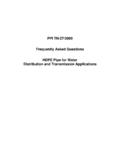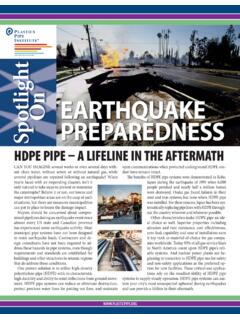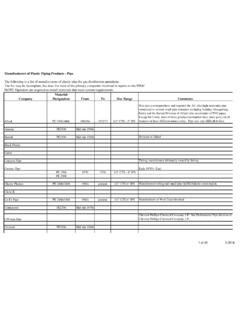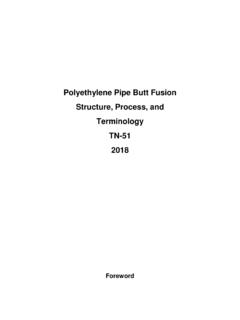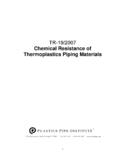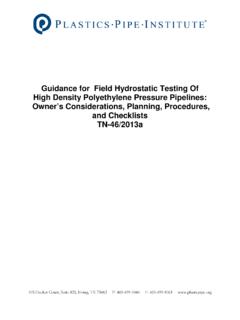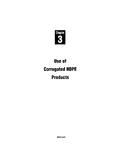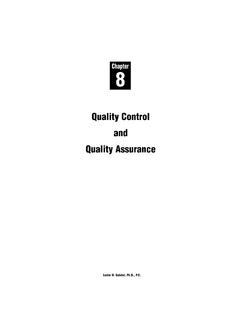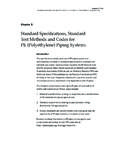Transcription of Chapter 7: Durability and Service Life - Conduit Division
1 < FIND FIND NEXT >. Chapter 7. Durability and Service life Lester H. Gabriel, , < FIND FIND NEXT >. Durability AND Service life . Durability of Drainage Pipes Durability is the property to resist erosion, material degradation and subsequent loss of function due to environmental and/or other Service conditions. Abrasion, chemical corrosion and electrochemical corrosion are the most common Durability concerns for drainage pipes. Erosion of drainage pipes by changes in flow patterns also may include: impingement by suspended solid particles or gas bubbles striking the surface.
2 Turbulence at pipe entrances and sharp bends, as well as aggregate and sediment deposits. Although an unlikely event for culverts and storm drains, high pressure and sub-atmospheric pressures that may be associated with high velocity flows may cause cavitation. Corrosive chemicals carried by the water expose the inverts of storm drain pipelines and culverts to corrosion-abrasion damage. The invert, host to both an electrolyte and varying concentrations of oxygen, may also be exposed to electrolytic corrosion. In hostile environments, materials such as unprotected concrete and unprotected steel develop corrosion products that are more brittle and thus more vulnerable to bedload abrasion.
3 As the corroded surface is stripped away, a fresh surface is exposed and new corrosion products form. If this cycle continues, eventual structural failure must be considered. Longevity of exposed pipes depends upon the qualities of the protective barriers. Palliative measures such as protective coatings, linings and pavements . are at risk of being eroded, cracked or delaminated. Corrosion Chemical corrosion of buried pipelines and culverts may occur in the presence of soils and waters containing acids, alkalis, dissolved salts and organic industrial wastes.
4 Surface water , ground water , sanitary effluent, acid rain, marine environments and mine drainage carry these contaminants. Some may occur in regions of high rainfall, others in arid locations. Sulfates, carbonates and chlorides degrade concrete a process often accelerated in regions where freeze-thaw cycles leave the material open to deeper penetration by the offending elements. Vitrified clay and plastic pipes are largely inert. Zinc, aluminum, aluminum-zinc alloy metallic coatings, asphaltic coat- ings with and without fiber and polymer coatings offer metal pipes varying measures of protection against soil-side and water -side chemical and electrochemical corrosion.
5 Chapter 7: Durability AND Service life . < FIND FIND NEXT >. Electrochemical corrosion of metal pipelines and culverts may occur where oxygen starved and oxygen rich locations on, and in the vicinity of, the pipe respectively become anodes and cathodes. A potential difference will cause current flow through a circuit composed of an electrolyte (soil moisture in the vicinity of the pipe or liquid within), an anode (a region on the pipe giving up electrons), a cathode (a region on the pipe accepting electrons) and the pipe as a conductor.
6 Loss of pipe material occurs at the anode. Stray direct current from a nearby electric railway or a cathodically protected utility is another source of potential difference. The degree of electrochemical degradation of corrugated steel pipe increases with lower pH and lower resistivity of soil and water . Reinforced concrete pipelines and culverts are also vulnerable to electrochemical corrosion. Permeable to moisture, concrete may serve as the electrolyte for highly anodic bare steel that can form where concrete cover has spalled off reinforcing bars.
7 A potent corrosion cell may result. Unlike metals, polyethylene pipes are non-conductors and are not vulnerable to galvanic corrosion associated with electrochemical attack. Polyethylene pipes are not degraded by pH extremes, aggressive salts or chemically induced corrosion. Unlike metals, HDPE pipes are non-conductors, insensitive to low soil resistivity, and therefore not subject to electrochemical corrosion. The Federal Lands Highway (FLH) policy is that plastic alternatives may be specified without regard to resistivity and pH of the site.
8 The same is true for many states. HDPE pipes are effective for drainage of hostile effluents, such as acid rain, acidic mine wastes, aggressive landfill leachates and effluents with high concentrations of road salts, fuels and motor oils. Laboratory studies indicate that only a negligible increase in abrasive wear of HDPE pipes may be expected when the pH drops from neutral (pH = 7) to medium-low acidic conditions (pH = 4). A reported field study showed that HDPE pipe is unaffected by acid mine run-off of pH ranging from to 4.
9 Abrasion Chemicals and abrasion are the most common Durability concerns for drainage pipes, especially when the effluent flows at high velocities. In test after test, results show that it takes longer to abrade through polyethylene than concrete and metallic pipes. In fact, in testing in both the United States and Europe, polyethylene has demonstrated wear rates up to 10 times less than steel. Chapter 7: Durability AND Service life . < FIND FIND NEXT >. Abrasives such as stones or debris can result in a mechanical wearing away of the pipe .
10 The extent of the problem depends on the type of abrasive, frequency that the material is in the pipe , velocity of the flow, and the type of the pipe material. The effect of abrasives may be seen in the pipe invert where exposure is most severe. Over time, abrasives can result in a loss of pipe strength or reduction in hydraulic quality as they gradually remove wall material. Abrasion is a precursor to accelerated corrosion. The Federal Lands Highway Project Development Design Manual has defined measures of abrasion for typical flow conditions (rather than a particular design flood) as follows: nonabrasive no bed load and very low velocities low abrasive minor bed loads of sand and velocities less than m/s (5 fps).
